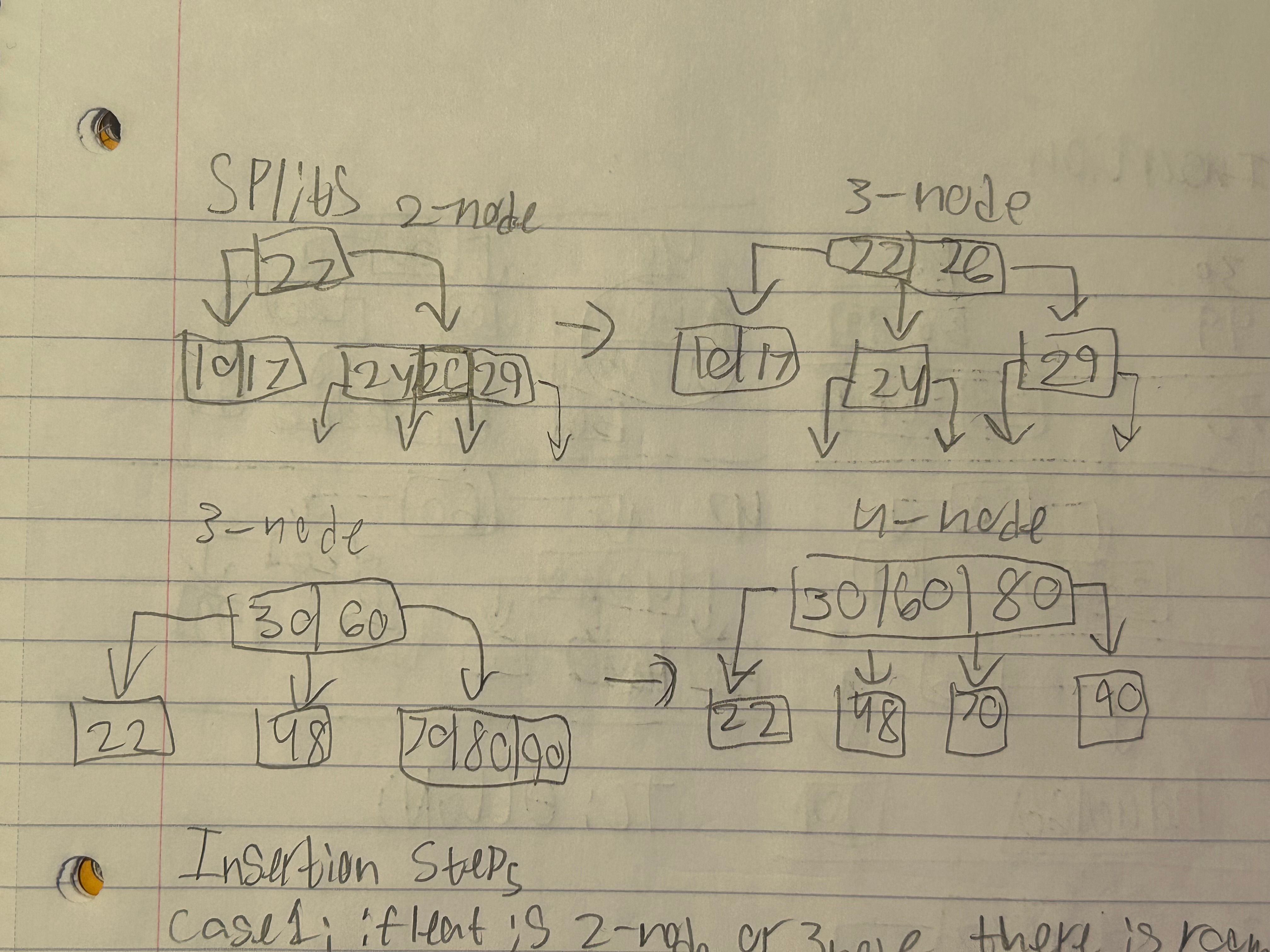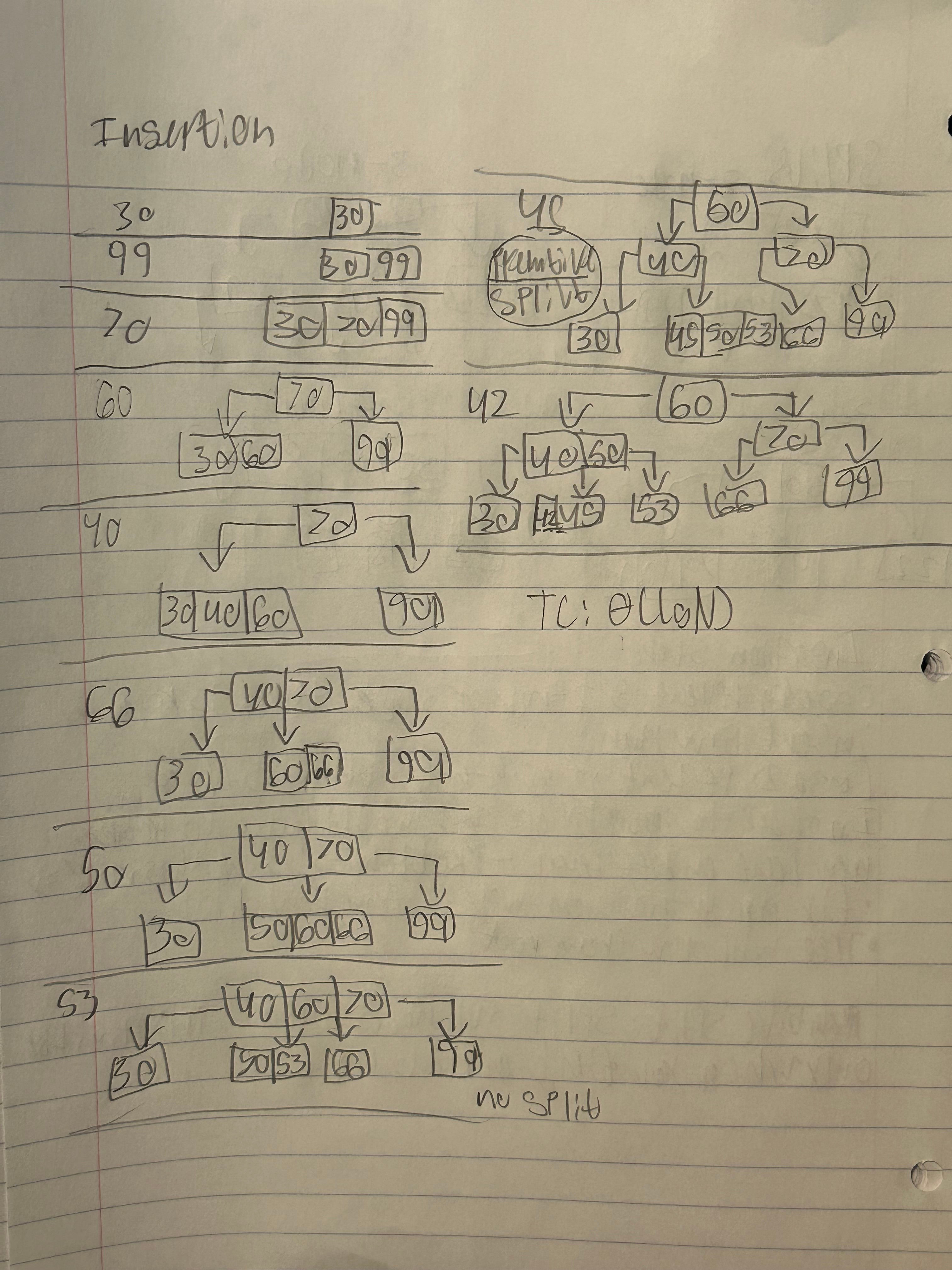Amortized Analysis
Amortized cost
Amorotized = cost of 1 operationAmorotized cost = total cost of the operation / N
- cost can be: TC, SC
| ex | cost |
|---|---|
| OP1 | 1 |
| OP2 | 2 |
| OP3 | 3 |
| OP4 | 1 |
| OP5 | 5 |
| OP6 | 1 |
| OP7 | 1 |
can have O(#)
Resizing Arrays
- insert 1 to 9
- if space cost to write = 1
- if arr full resize
- double space
- copy old to new
| Cost | Add | Visual of Current space allocated |
|---|---|---|
| 1 | 1 | |
| 1+1 | 2 | [1] Full |
| 2+1 | 3 | [1][2] Full |
| 1 | 4 | [1][2][3][4] |
| 4+1 | 5 | [1][2][3][4][5][6][7][8] |
| 1 | 6 | [1][2][3][4][5][6][7][8] |
| 1 | 7 | [1][2][3][4][5][6][7][8] |
| 1 | 8 | [1][2][3][4][5][6][7][8] |
| 8+1 | 9 | [1][2][3][4][5][6][7][8][9][10][11][12][13][14][15][16] |
Amortized cost:
copy cost = 1+2+4+8 = 14
General form:
All copy cost:
Amortized cost:
Dynamic Programming
Dynamic Programming (DP) applies when a problem has both of these properties
- Optimal substructure: "Optimal solutions to a problem incorprate optimal solutions to related subproblems, which we may Solve independtly"
- Overlapping subproblems: "a recursive algorithm revists/repeats the same problem repeatedly"
Dynamic programming is used to:
- solve optimization problems that have the above properties
- solve counting problems (e.g. matrix traversal)
- Speed up existing recursive implementations of problems that have overlapping subproblems (e.g. Fibonacci sequence)
- Top down is usually the recursive way of solving these problems which have exponential time,
- a better way of doing top down is a memoization version of it, saving values you have used already.
Steps to get a iterative (bottom up) solution
- Identify trivial problem
- typically where the size is 0
- Look at the last step/choice in an optimal solution:
- Assuming an optimal solution, what is the last action in completing it?
- Are there more than one options for the last action?
- If you consider each action, what is the smaller problem that you would combine with the last action?
- Assume that you have the optimal answer to that smaller problem.
- Generate all these solutions
- Compute the value (gain or cost) for each of these solutions.
- Keep the optimal one (max or min based on the problem)
- Make a 1D or 2D array and start filling in the answers from smallest to largest problem
I'll just list the slides here because Prof. Stefan does a better job than i could do with my notes
Knapsack Problem
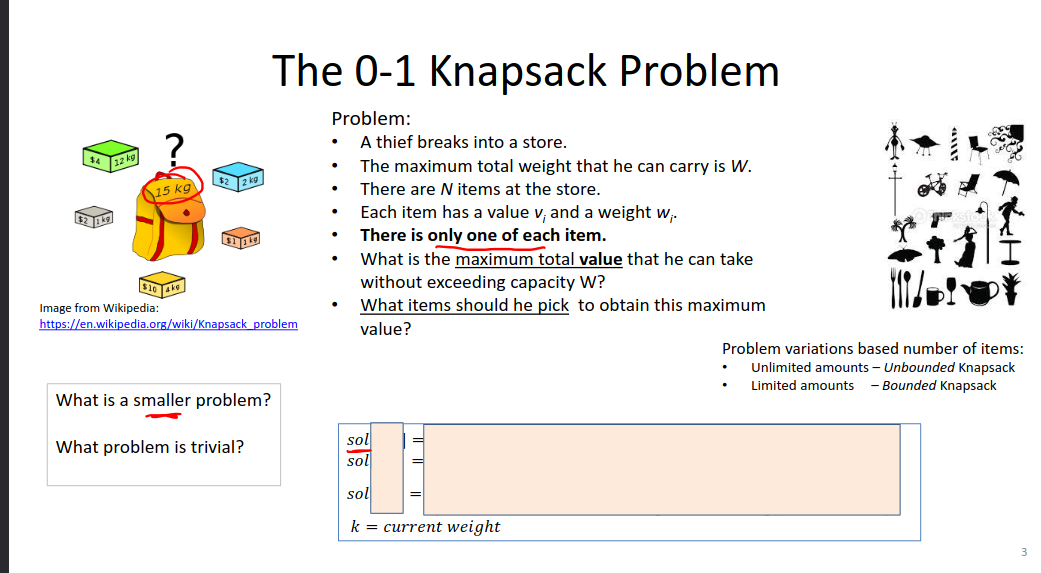
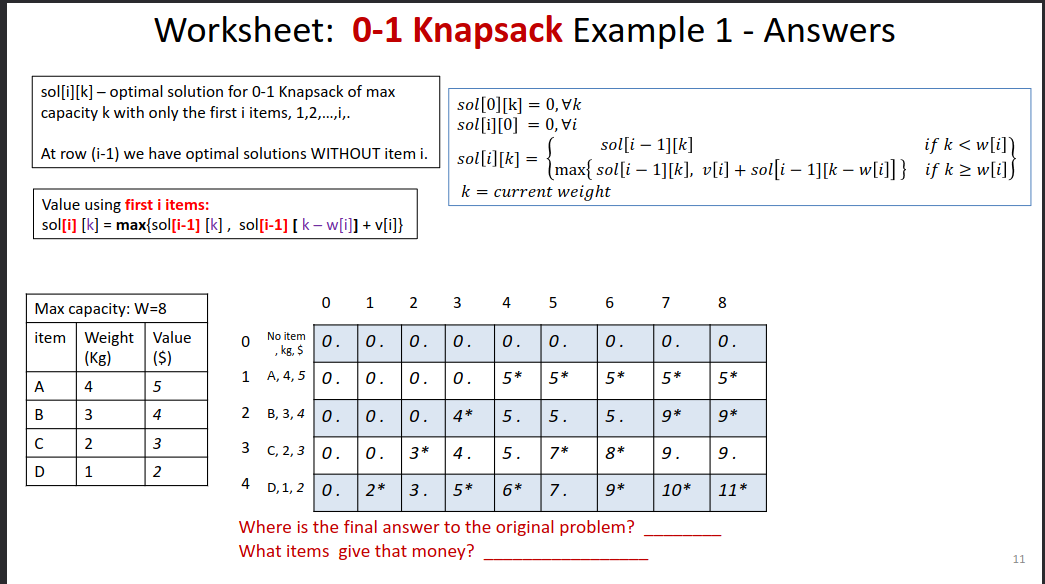
Knapsack code
int knapsack01(int W, int n, int * v, int *w)
{
int with_i = 0;
int sol[n+1][W+1]; // create sol arr n+1 rows and W+1 cols
for (int k = 0; k<=W; k++)
{
sol[0][k] = 0; //loop through arr 1 setting all 0 row position first
}
for(int i = 1; i<=n; i++) //loop through rows
{
for(int k=0; k<=W; k++) //loop through columns
{
sol[i][k] = sol[i-1][k]; //without item i
if(k > w[i]) // if current weight > capacity
{
with_i = v[i]+sol[i-1][k-w[i]];
if(sol[i][k] < with_i) // if current sol val < with_i
{
sol[i][k] = with_i; //take with item i
}
}
}
}
return sol[n][W]; //return solution
}- Time: Θ(nW)
- Space: Θ(nW)
- pseudo polynomial in W // need Θ(n) bits to store n items (values and weights) , but only log_2(W) bits to store W
Improving the memory usage
- Optimize the memory usage by Storing only smaller problems that are needed
- store either 2 rows or 2 columns
- The choices cannot be recovered anymore (i.e. cannot reocver what items to pick to achieve the computed value)
- Space complexity: Θ(W)
Job Scheduling
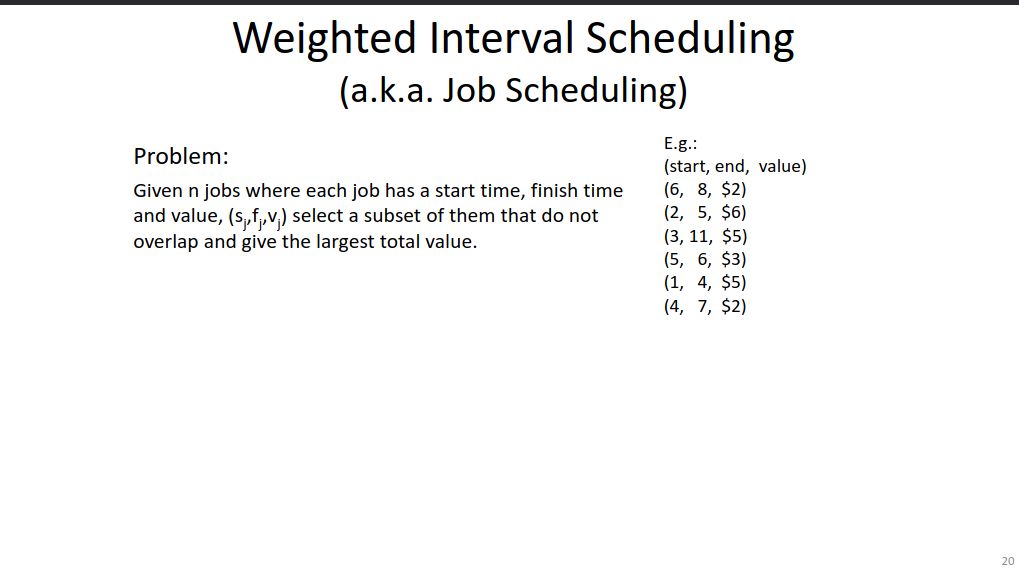
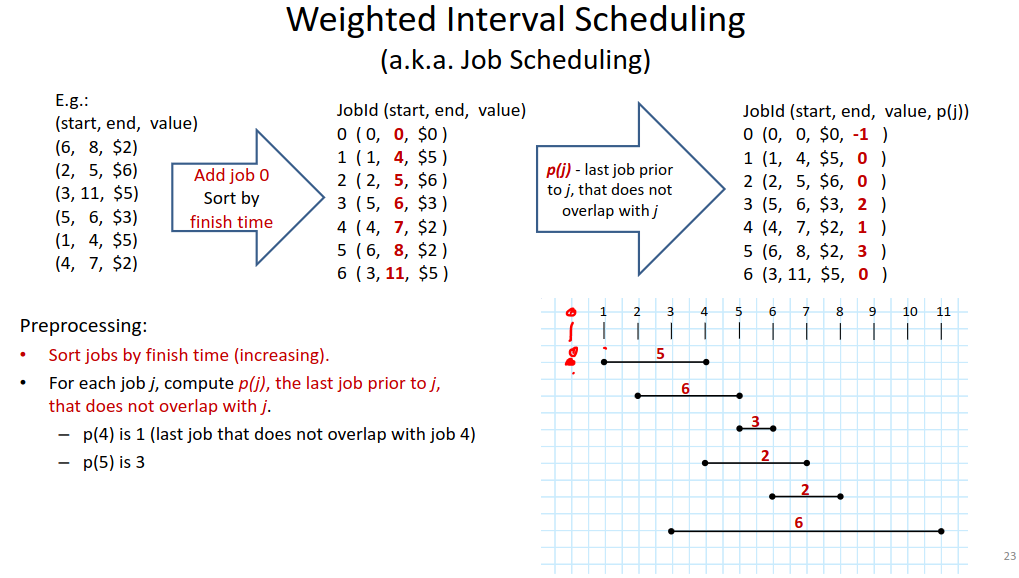
Problem:
- Given n jobs where each job has a start time, finish time and value, (sj,fj,vj) select a subset of them that do not overlap and give the largest total value.
Preprocessing:
- Sort jobs in increasing order of their finish time. (what the last slide did)
- For each job, j, compute the last job prior to j, p(j) that does not overlap with j.
Solve the problem:
- Steps: one step for each job
- Choice: Pick/Don't
- Smaller problems: 2:
- pb1 = jobs 1 to j-1 => sol(j-1)
- pb2 = jobs 1 to p(j) (where p(j) is the last job before j that doesnt overlap with j. => sol(p(j)))
- Solution function (Gives money value: sol(j) = the most money we can make with using jobs 1,2,...,j)
- Time Complexity:
- O(n) (if data is preprocessed)
- O(nlgn) (with preprocessing)
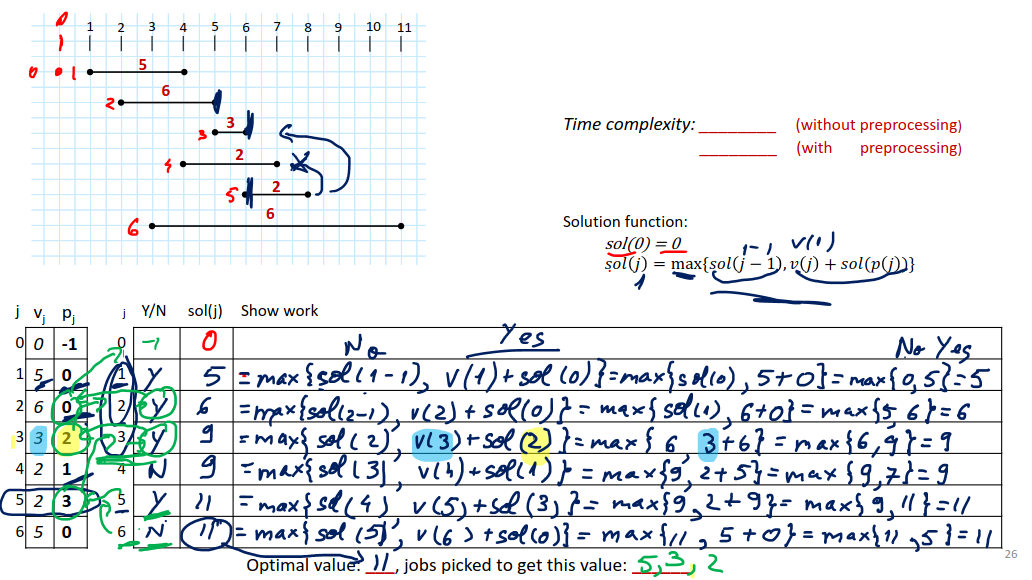
- Pj tells us what sol(j) doesnt overlap
- Vj is value of that job
- j is idx or Job #
- Basically what we are saying is: was my previous choice better or is the new choice better?
2-3-4 Trees
This was voted to be put on exam 2 rather than the first, though idk if we should've done that...Insertion & Deletion TC: O(lgN)
- 2-Nodes: 1 item, 2 children
- 3-Nodes: 2 item, 3 children
- 4-Nodes: 3 item, 4 children
keys in left: <= k; keys in right: > k
All leaves must be at same level, a node that isnt a leaf will have all children around that item (no gaps) (grows and shrinks from root)
This is how a filled one looks like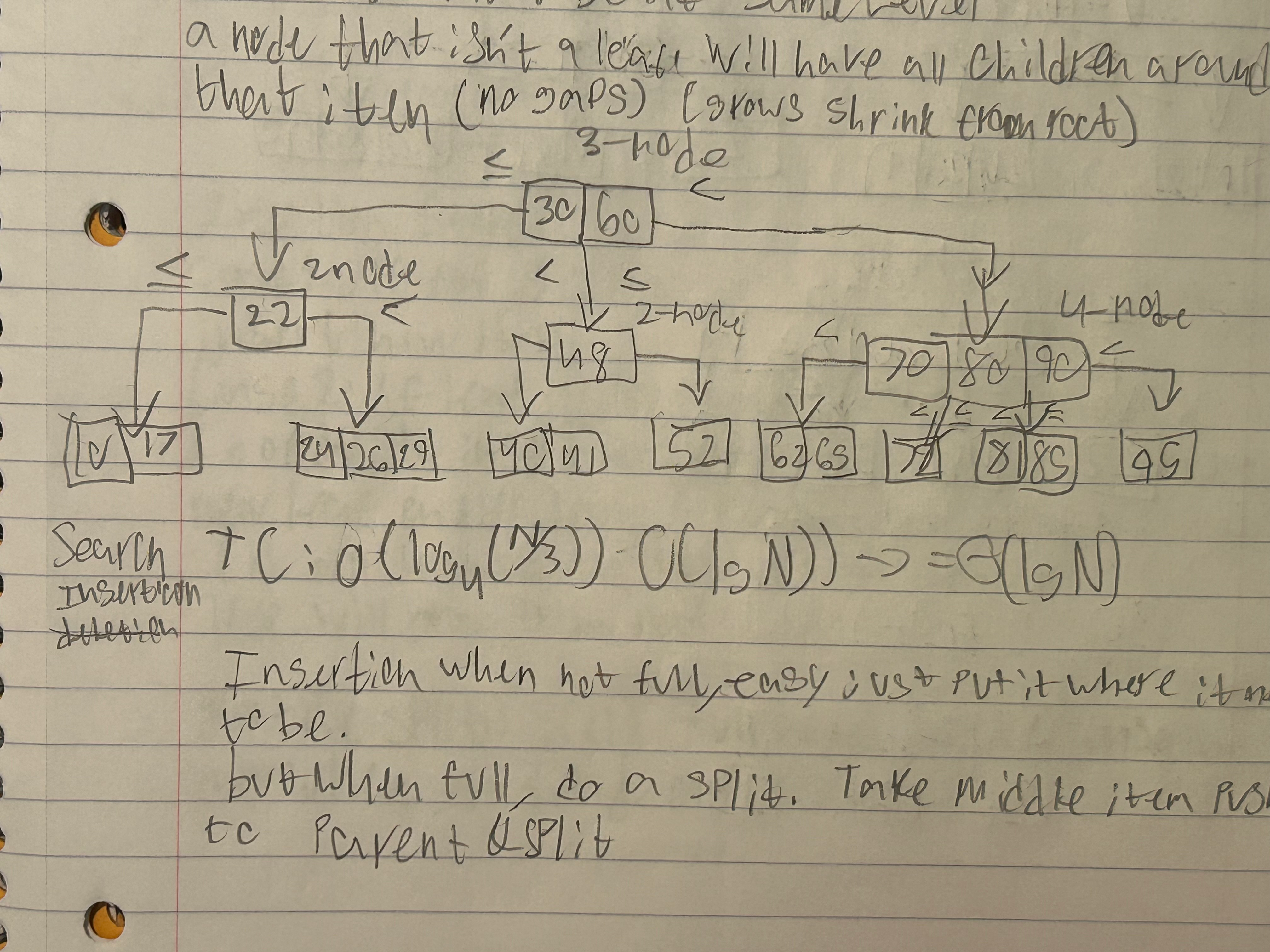

Time complexity:
Insertion when not full:
- Easy to do just put it where it needs to be Insertion when full:
- We have to do a split.
- Take the middle item put it to the parent
